Jianyu Zhang
AgriGPT: a Large Language Model Ecosystem for Agriculture
Aug 12, 2025Abstract:Despite the rapid progress of Large Language Models (LLMs), their application in agriculture remains limited due to the lack of domain-specific models, curated datasets, and robust evaluation frameworks. To address these challenges, we propose AgriGPT, a domain-specialized LLM ecosystem for agricultural usage. At its core, we design a multi-agent scalable data engine that systematically compiles credible data sources into Agri-342K, a high-quality, standardized question-answer (QA) dataset. Trained on this dataset, AgriGPT supports a broad range of agricultural stakeholders, from practitioners to policy-makers. To enhance factual grounding, we employ Tri-RAG, a three-channel Retrieval-Augmented Generation framework combining dense retrieval, sparse retrieval, and multi-hop knowledge graph reasoning, thereby improving the LLM's reasoning reliability. For comprehensive evaluation, we introduce AgriBench-13K, a benchmark suite comprising 13 tasks with varying types and complexities. Experiments demonstrate that AgriGPT significantly outperforms general-purpose LLMs on both domain adaptation and reasoning. Beyond the model itself, AgriGPT represents a modular and extensible LLM ecosystem for agriculture, comprising structured data construction, retrieval-enhanced generation, and domain-specific evaluation. This work provides a generalizable framework for developing scientific and industry-specialized LLMs. All models, datasets, and code will be released to empower agricultural communities, especially in underserved regions, and to promote open, impactful research.
Scale-Invariance Drives Convergence in AI and Brain Representations
Jun 13, 2025Abstract:Despite variations in architecture and pretraining strategies, recent studies indicate that large-scale AI models often converge toward similar internal representations that also align with neural activity. We propose that scale-invariance, a fundamental structural principle in natural systems, is a key driver of this convergence. In this work, we propose a multi-scale analytical framework to quantify two core aspects of scale-invariance in AI representations: dimensional stability and structural similarity across scales. We further investigate whether these properties can predict alignment performance with functional Magnetic Resonance Imaging (fMRI) responses in the visual cortex. Our analysis reveals that embeddings with more consistent dimension and higher structural similarity across scales align better with fMRI data. Furthermore, we find that the manifold structure of fMRI data is more concentrated, with most features dissipating at smaller scales. Embeddings with similar scale patterns align more closely with fMRI data. We also show that larger pretraining datasets and the inclusion of language modalities enhance the scale-invariance properties of embeddings, further improving neural alignment. Our findings indicate that scale-invariance is a fundamental structural principle that bridges artificial and biological representations, providing a new framework for evaluating the structural quality of human-like AI systems.
HybridProver: Augmenting Theorem Proving with LLM-Driven Proof Synthesis and Refinement
May 21, 2025Abstract:Formal methods is pivotal for verifying the reliability of critical systems through rigorous mathematical proofs. However, its adoption is hindered by labor-intensive manual proofs and the expertise required to use theorem provers. Recent advancements in large language models (LLMs) offer new opportunities for automated theorem proving. Two promising approaches are generating tactics step by step and generating a whole proof directly with an LLM. However, existing work makes no attempt to combine the two approaches. In this work, we introduce HybridProver, a dual-model proof synthesis framework that combines tactic-based generation and whole-proof synthesis to harness the benefits of both approaches. HybridProver generates whole proof candidates for evaluation directly, then extracts proof sketches from those candidates. It then uses a tactic-based generation model that integrates automated tools to complete the sketches via stepwise refinement. We implement HybridProver for the Isabelle theorem prover and fine-tune LLMs on our optimized Isabelle datasets. Evaluation on the miniF2F dataset illustrates HybridProver's effectiveness. We achieve a 59.4% success rate on miniF2F, where the previous SOTA is 56.1%. Our ablation studies show that this SOTA result is attributable to combining whole-proof and tactic-based generation. Additionally, we show how the dataset quality, training parameters, and sampling diversity affect the final result during automated theorem proving with LLMs. All of our code, datasets, and LLMs are open source.
Enhanced Semi-Supervised Stamping Process Monitoring with Physically-Informed Feature Extraction
Apr 30, 2025Abstract:In tackling frequent anomalies in stamping processes, this study introduces a novel semi-supervised in-process anomaly monitoring framework, utilizing accelerometer signals and physics information, to capture the process anomaly effectively. The proposed framework facilitates the construction of a monitoring model with imbalanced sample distribution, which enables in-process condition monitoring in real-time to prevent batch anomalies, which helps to reduce batch defects risk and enhance production yield. Firstly, to effectively capture key features from raw data containing redundant information, a hybrid feature extraction algorithm is proposed to utilize data-driven methods and physical mechanisms simultaneously. Secondly, to address the challenge brought by imbalanced sample distribution, a semi-supervised anomaly detection model is established, which merely employs normal samples to build a golden baseline model, and a novel deviation score is proposed to quantify the anomaly level of each online stamping stroke. The effectiveness of the proposed feature extraction method is validated with various classification algorithms. A real-world in-process dataset from stamping manufacturing workshop is employed to illustrate the superiority of proposed semi-supervised framework with enhance performance for process anomaly monitoring.
AI for the Open-World: the Learning Principles
Apr 20, 2025Abstract:During the past decades, numerous successes of AI has been made on "specific capabilities", named closed-world, such as artificial environments or specific real-world tasks. This well-defined narrow capability brings two nice benefits, a clear criterion of success and the opportunity to collect a lot of examples. The criteria not only reveal whether a machine has achieved a goal, but reveal how the machine falls short of the goal. As a result, human designers can fix the problems one after the other until the machine is deemed good enough for the task. Furthermore, the large set of collected examples reduces the difficulty of this problem-fixing process (by the central limit theorem). Do the success in closed-world translate into broad open-world, where a machine is required to perform any task that a human could possibly undertake with fewer examples and less priori knowledge from human designers? No. Because competence in a specific task provides little insight in handling other tasks, the valuable criteria for specific tasks become helpless when handling broader unseen tasks. Furthermore, due to the shortage of examples in unseen tasks, central limit theorem does not stand on our side. At the end, human designers lose the oscilloscope to "hack" an AI system for the open-world. Achieving AI for the open-world requires unique learning principles and innovated techniques, which are different from the ones in building AI for the closed-world. This thesis explores necessary learning principles required to construct AI for the open-world, including rich features (analogy a large tool box), disentangled representation (an organized tool box), and inference-time learning (a tool-savvy hand). Driven by the learning principles, this thesis further proposes techniques to use the learning principles, conducts enormous large-scale experiments to verify the learning principles.
Psychometric-Based Evaluation for Theorem Proving with Large Language Models
Feb 02, 2025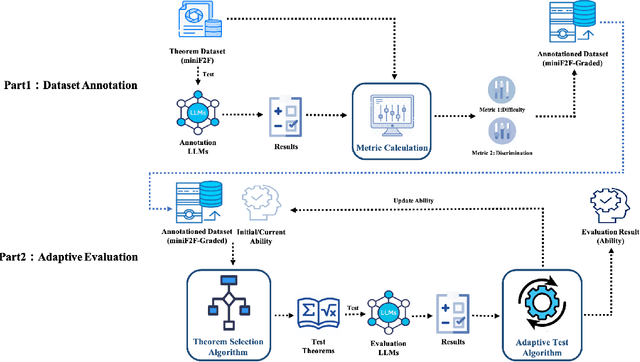

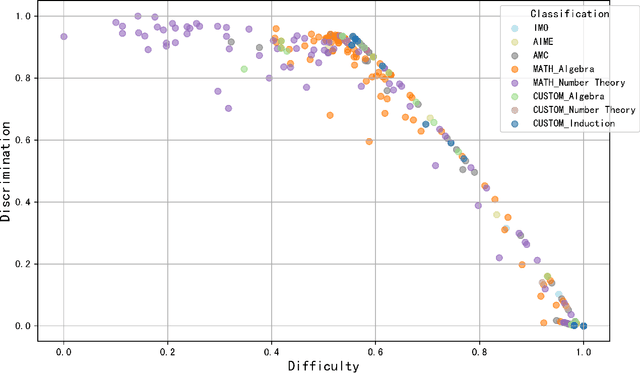

Abstract:Large language models (LLMs) for formal theorem proving have become a prominent research focus. At present, the proving ability of these LLMs is mainly evaluated through proof pass rates on datasets such as miniF2F. However, this evaluation method overlooks the varying importance of theorems. As a result, it fails to highlight the real performance disparities between LLMs and leads to high evaluation costs. This study proposes a psychometric-based evaluation method for theorem proving with LLMs, comprising two main components: Dataset Annotation and Adaptive Evaluation. First, we propose a metric calculation method to annotate the dataset with difficulty and discrimination metrics. Specifically, we annotate each theorem in the miniF2F dataset and grade them into varying difficulty levels according to the performance of LLMs, resulting in an enhanced dataset: miniF2F-Graded. Experimental results show that the difficulty grading in miniF2F-Graded better reflects the theorem difficulty perceived by LLMs. Secondly, we design an adaptive evaluation method to dynamically select the most suitable theorems for testing based on the annotated metrics and the real-time performance of LLMs. We apply this method to evaluate 10 LLMs. The results show that our method finely highlights the performance disparities between LLMs. It also reduces evaluation costs by using only 23% of the theorems in the dataset.
Incorporating Feature Pyramid Tokenization and Open Vocabulary Semantic Segmentation
Dec 18, 2024



Abstract:The visual understanding are often approached from 3 granular levels: image, patch and pixel. Visual Tokenization, trained by self-supervised reconstructive learning, compresses visual data by codebook in patch-level with marginal information loss, but the visual tokens does not have semantic meaning. Open Vocabulary semantic segmentation benefits from the evolving Vision-Language models (VLMs) with strong image zero-shot capability, but transferring image-level to pixel-level understanding remains an imminent challenge. In this paper, we treat segmentation as tokenizing pixels and study a united perceptual and semantic token compression for all granular understanding and consequently facilitate open vocabulary semantic segmentation. Referring to the cognitive process of pretrained VLM where the low-level features are progressively composed to high-level semantics, we propose Feature Pyramid Tokenization (PAT) to cluster and represent multi-resolution feature by learnable codebooks and then decode them by joint learning pixel reconstruction and semantic segmentation. We design loosely coupled pixel and semantic learning branches. The pixel branch simulates bottom-up composition and top-down visualization of codebook tokens, while the semantic branch collectively fuse hierarchical codebooks as auxiliary segmentation guidance. Our experiments show that PAT enhances the semantic intuition of VLM feature pyramid, improves performance over the baseline segmentation model and achieves competitive performance on open vocabulary semantic segmentation benchmark. Our model is parameter-efficient for VLM integration and flexible for the independent tokenization. We hope to give inspiration not only on improving segmentation but also on semantic visual token utilization.
A Framework For Image Synthesis Using Supervised Contrastive Learning
Dec 05, 2024Abstract:Text-to-image (T2I) generation aims at producing realistic images corresponding to text descriptions. Generative Adversarial Network (GAN) has proven to be successful in this task. Typical T2I GANs are 2 phase methods that first pretrain an inter-modal representation from aligned image-text pairs and then use GAN to train image generator on that basis. However, such representation ignores the inner-modal semantic correspondence, e.g. the images with same label. The semantic label in priory describes the inherent distribution pattern with underlying cross-image relationships, which is supplement to the text description for understanding the full characteristics of image. In this paper, we propose a framework leveraging both inter- and inner-modal correspondence by label guided supervised contrastive learning. We extend the T2I GANs to two parameter-sharing contrast branches in both pretraining and generation phases. This integration effectively clusters the semantically similar image-text pair representations, thereby fostering the generation of higher-quality images. We demonstrate our framework on four novel T2I GANs by both single-object dataset CUB and multi-object dataset COCO, achieving significant improvements in the Inception Score (IS) and Frechet Inception Distance (FID) metrics of imagegeneration evaluation. Notably, on more complex multi-object COCO, our framework improves FID by 30.1%, 27.3%, 16.2% and 17.1% for AttnGAN, DM-GAN, SSA-GAN and GALIP, respectively. We also validate our superiority by comparing with other label guided T2I GANs. The results affirm the effectiveness and competitiveness of our approach in advancing the state-of-the-art GAN for T2I generation
GMS-VINS:Multi-category Dynamic Objects Semantic Segmentation for Enhanced Visual-Inertial Odometry Using a Promptable Foundation Model
Nov 28, 2024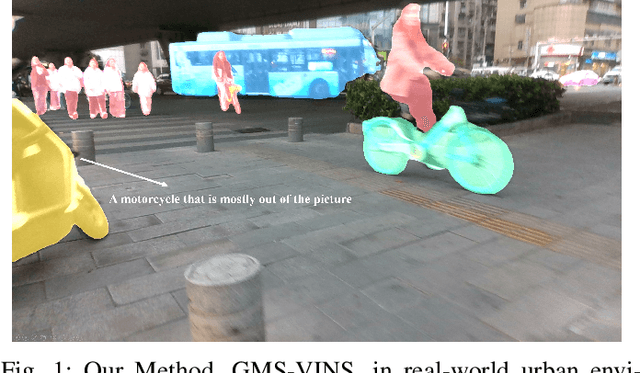
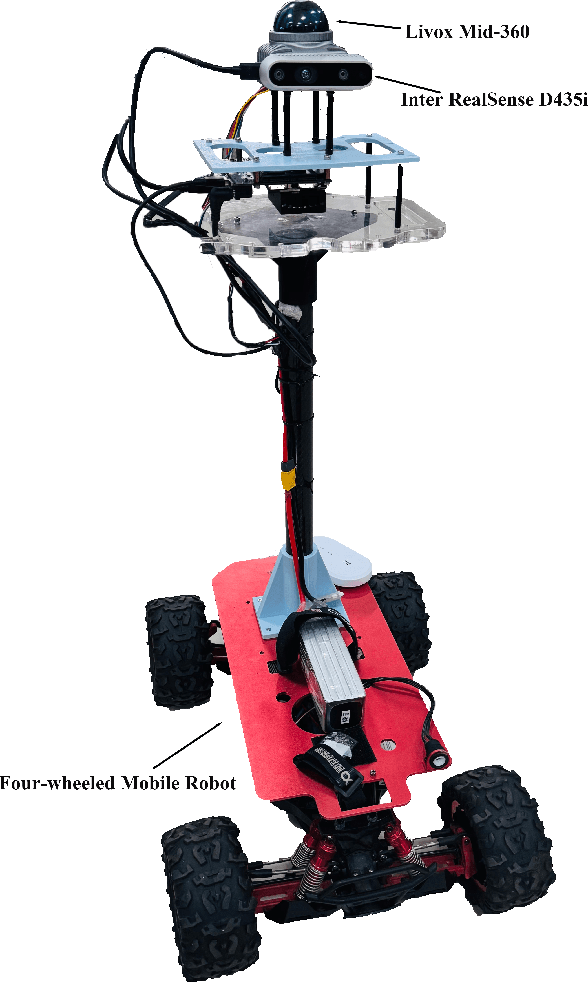
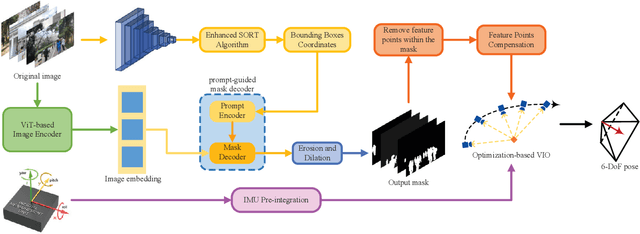
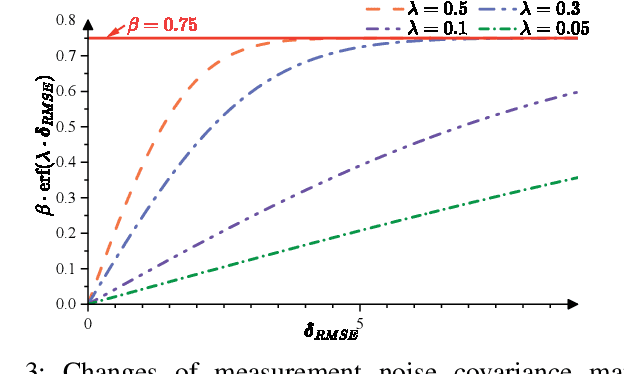
Abstract:Visual-inertial odometry (VIO) is widely used in various fields, such as robots, drones, and autonomous vehicles, due to its low cost and complementary sensors. Most VIO methods presuppose that observed objects are static and time-invariant. However, real-world scenes often feature dynamic objects, compromising the accuracy of pose estimation. These moving entities include cars, trucks, buses, motorcycles, and pedestrians. The diversity and partial occlusion of these objects present a tough challenge for existing dynamic object removal techniques. To tackle this challenge, we introduce GMS-VINS, which integrates an enhanced SORT algorithm along with a robust multi-category segmentation framework into VIO, thereby improving pose estimation accuracy in environments with diverse dynamic objects and frequent occlusions. Leveraging the promptable foundation model, our solution efficiently tracks and segments a wide range of object categories. The enhanced SORT algorithm significantly improves the reliability of tracking multiple dynamic objects, especially in urban settings with partial occlusions or swift movements. We evaluated our proposed method using multiple public datasets representing various scenes, as well as in a real-world scenario involving diverse dynamic objects. The experimental results demonstrate that our proposed method performs impressively in multiple scenarios, outperforming other state-of-the-art methods. This highlights its remarkable generalization and adaptability in diverse dynamic environments, showcasing its potential to handle various dynamic objects in practical applications.
MagicPIG: LSH Sampling for Efficient LLM Generation
Oct 21, 2024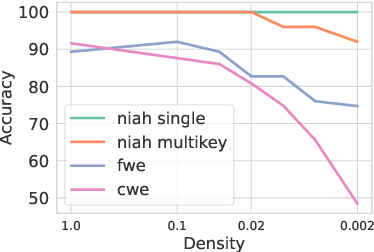
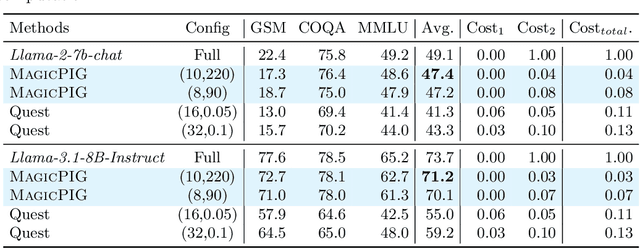


Abstract:Large language models (LLMs) with long context windows have gained significant attention. However, the KV cache, stored to avoid re-computation, becomes a bottleneck. Various dynamic sparse or TopK-based attention approximation methods have been proposed to leverage the common insight that attention is sparse. In this paper, we first show that TopK attention itself suffers from quality degradation in certain downstream tasks because attention is not always as sparse as expected. Rather than selecting the keys and values with the highest attention scores, sampling with theoretical guarantees can provide a better estimation for attention output. To make the sampling-based approximation practical in LLM generation, we propose MagicPIG, a heterogeneous system based on Locality Sensitive Hashing (LSH). MagicPIG significantly reduces the workload of attention computation while preserving high accuracy for diverse tasks. MagicPIG stores the LSH hash tables and runs the attention computation on the CPU, which allows it to serve longer contexts and larger batch sizes with high approximation accuracy. MagicPIG can improve decoding throughput by $1.9\sim3.9\times$ across various GPU hardware and achieve 110ms decoding latency on a single RTX 4090 for Llama-3.1-8B-Instruct model with a context of 96k tokens. The code is available at \url{https://github.com/Infini-AI-Lab/MagicPIG}.
 Add to Chrome
Add to Chrome Add to Firefox
Add to Firefox Add to Edge
Add to Edge